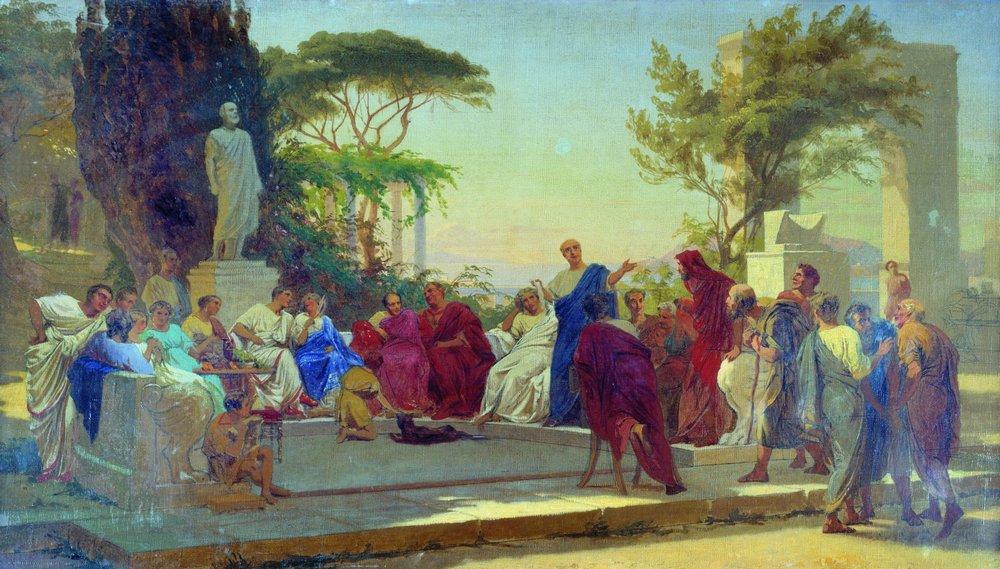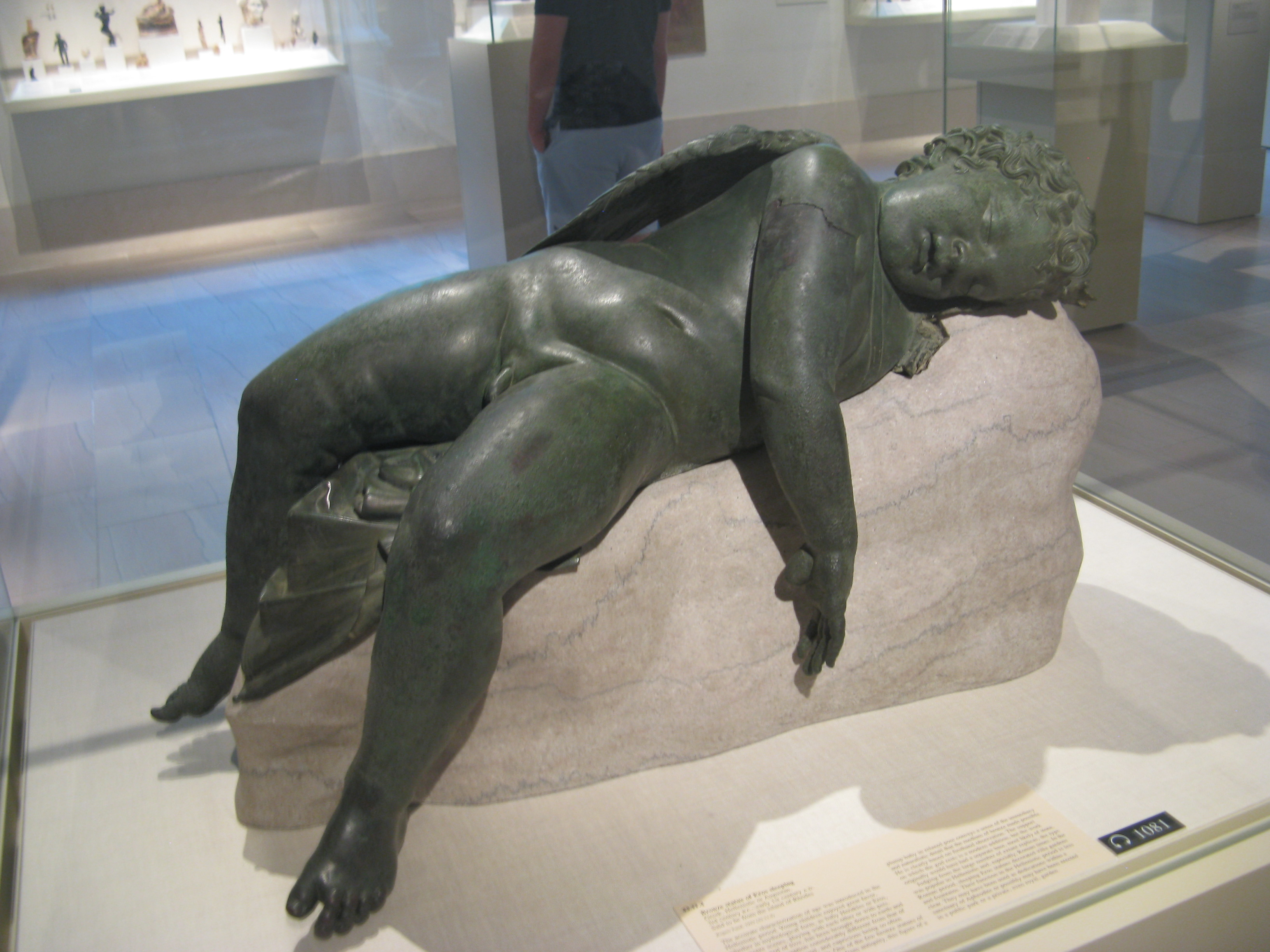|
Lucius Domitius Ahenobarbus (consul 54 BC)
Lucius Domitius Ahenobarbus, consul in 54 BC, was an enemy of Julius Caesar and a strong supporter of the aristocratic () party in the late Roman Republic. He was Nero's great-great-grandfather. Biography Ahenobarbus was born as the son of consul Gnaeus Domitius Ahenobarbus. His grandfather Gnaeus Domitius Ahenobarbus was a general and consul who led a campaign to conquer southern Gaul against the Allobroges. He is first mentioned in 70 BC by Cicero as a witness against Verres. In 61, he was curule aedile, when he exhibited a hundred Numidian lions, and continued the games so long that the people were obliged to leave the circus before the exhibition was over, in order to take food, which was the first time they had done so. This pause in the games was called ''diludium''. He married Porcia, the sister of Cato the Younger, and in his aedileship supported the latter in his proposals against bribery at elections, which were directed against Pompey, who was purchasing votes ... [...More Info...] [...Related Items...] OR: [Wikipedia] [Google] [Baidu] |
Palaepharsalus
Palaepharsalus or Palaipharsalos ( - meaning "Old Pharsalus") was a town of ancient Thessaly, from which the town moved to the later location of Pharsalus. The geographer Strabo writes of two towns, Palaepharsalus and Pharsalus, existing in historical times. His statement that the Thetideion, the temple to Thetis south of Scotussa, was "near both the Pharsaloi, the Old and the New," seems to imply that Palaeopharsalus was not itself close by Pharsalus. Although the battle of 48 BCE between Julius Caesar and Pompey is often called the Battle of Pharsalus by modern historians, four ancient writers – the author of the ''Bellum Alexandrinum'', Frontinus, Eutropius, and Orosius – place it specifically at Palaepharsalus. In 198 BCE Philip V sacked Palaepharsalus but apparently spared Pharsalus itself. Location John D. Morgan in his article “Palae-pharsalus – the Battle and the Town”, discusses the various locations which have been proposed for the location of P ... [...More Info...] [...Related Items...] OR: [Wikipedia] [Google] [Baidu] |
Dictionary Of Greek And Roman Biography And Mythology
The ''Dictionary of Greek and Roman Biography and Mythology'' is a biographical dictionary of classical antiquity, edited by William Smith (lexicographer), William Smith and originally published in London by John Taylor (English publisher), Taylor, Walton (and Maberly) and John Murray (publishing house), John Murray from 1844 to 1849 in three volumes of more than 3,700 pages. It is a classic work of 19th-century lexicography. The work is a companion to Smith's ''Dictionary of Greek and Roman Antiquities'' and ''Dictionary of Greek and Roman Geography''. Authors and scope The work lists thirty-five authors in addition to the editor, who was also the author of the unsigned articles. The other authors were Classics, classical scholars, primarily from University of Oxford, Oxford, University of Cambridge, Cambridge, Rugby School, and the University of Bonn, but some were from other institutions. Many of the mythological entries were the work of the German expatriate Leonhard Schmit ... [...More Info...] [...Related Items...] OR: [Wikipedia] [Google] [Baidu] |
Horace
Quintus Horatius Flaccus (; 8 December 65 BC – 27 November 8 BC), Suetonius, Life of Horace commonly known in the English-speaking world as Horace (), was the leading Roman lyric poet during the time of Augustus (also known as Octavian). The rhetorician Quintilian regarded his '' Odes'' as the only Latin lyrics worth reading: "He can be lofty sometimes, yet he is also full of charm and grace, versatile in his figures, and felicitously daring in his choice of words."Quintilian 10.1.96. The only other lyrical poet Quintilian thought comparable with Horace was the now obscure poet/metrical theorist, Caesius Bassus (R. Tarrant, ''Ancient Receptions of Horace'', 280) Horace also crafted elegant hexameter verses ('' Satires'' and '' Epistles'') and caustic iambic poetry ('' Epodes''). The hexameters are amusing yet serious works, friendly in tone, leading the ancient satirist Persius to comment: "as his friend laughs, Horace slyly puts his finger on his every fault; once let ... [...More Info...] [...Related Items...] OR: [Wikipedia] [Google] [Baidu] |
Natural History (Pliny)
The ''Natural History'' () is a Latin work by Pliny the Elder. The largest single work to have survived from the Roman Empire to the modern day, the ''Natural History'' compiles information gleaned from other ancient authors. Despite the work's title, its subject area is not limited to what is today understood by natural history; Pliny himself defines his scope as "the natural world, or life". It is encyclopedic in scope, but its structure is not like that of a modern encyclopedia. It is the only work by Pliny to have survived, and the last that he published. He published the first 10 books in AD 77, but had not made a final revision of the remainder at the time of Pliny the Elder#Death, his death during the Eruption of Mount Vesuvius in 79 AD, AD 79 eruption of Vesuvius. The rest was published posthumously by Pliny's nephew, Pliny the Younger. The work is divided into 37 books, organised into 10 volumes. These cover topics including astronomy, mathematics, geography, ethn ... [...More Info...] [...Related Items...] OR: [Wikipedia] [Google] [Baidu] |
Pliny The Elder
Gaius Plinius Secundus (AD 23/24 79), known in English as Pliny the Elder ( ), was a Roman Empire, Roman author, Natural history, naturalist, and naval and army commander of the early Roman Empire, and a friend of the Roman emperor, emperor Vespasian. He wrote the encyclopedic (''Natural History''), a comprehensive thirty-seven-volume work covering a vast array of topics on human knowledge and the natural world, which became an editorial model for encyclopedias. He spent most of his spare time studying, writing, and investigating natural and geographic phenomena in the field. Among Pliny's greatest works was the twenty-volume ''Bella Germaniae'' ("The History of the German Wars"), which is Lost literary work, no longer extant. ''Bella Germaniae'', which began where Aufidius Bassus' ''Libri Belli Germanici'' ("The War with the Germans") left off, was used as a source by other prominent Roman historians, including Plutarch, Tacitus, and Suetonius. Tacitus may have used ''Bella Ger ... [...More Info...] [...Related Items...] OR: [Wikipedia] [Google] [Baidu] |
Cassius Dio
Lucius Cassius Dio (), also known as Dio Cassius ( ), was a Roman historian and senator of maternal Greek origin. He published 80 volumes of the history of ancient Rome, beginning with the arrival of Aeneas in Italy. The volumes documented the subsequent founding of Rome (753 BC), the formation of the Republic (509 BC), and the creation of the Empire (27 BC) up until 229 AD, during the reign of Severus Alexander. Written in Koine Greek over 22 years, Dio's work covers approximately 1,000 years of history. Many of his books have survived intact, alongside summaries edited by later authors such as Xiphilinus, a Byzantine monk of the 11th century, and Zonaras, a Byzantine chronicler of the 12th century. Biography Lucius Cassius Dio was the son of Cassius Apronianus, a Roman senator and member of the Cassia gens, who was born and raised at Nicaea in Bithynia. Byzantine tradition maintains that Dio's mother was the daughter or sister of the Greek orator and philosopher, ... [...More Info...] [...Related Items...] OR: [Wikipedia] [Google] [Baidu] |
Numidian Lion
The Barbary lion was a population of the lion subspecies ''Panthera leo leo''. It was also called North African lion, Atlas lion, and Egyptian lion. It lived in the mountains and deserts of the Maghreb of North Africa from Morocco to Egypt. It was eradicated following the spread of firearms and bounties for shooting lions. A comprehensive review of hunting and sighting records revealed that small groups of lions may have survived in Algeria until the early 1960s, and in Morocco until the mid-1960s. Today, it is locally extinct in this region. Fossils of the Barbary lion dating to between 100,000 and 110,000 years were found in the cave of Bizmoune near Essaouira. Until 2017, the Barbary lion was considered a distinct lion subspecies. Results of morphological and genetic analyses of lion samples from North Africa showed that the Barbary lion does not differ significantly from the Asiatic lion and falls into the same subclade. This North African/Asian subclade is closely relat ... [...More Info...] [...Related Items...] OR: [Wikipedia] [Google] [Baidu] |
Curule Aedile
Aedile ( , , from , "temple edifice") was an elected office of the Roman Republic. Based in Rome, the aediles were responsible for maintenance of public buildings () and regulation of public festivals. They also had powers to enforce public order and duties to ensure the city of Rome was well supplied and its civil infrastructure well maintained, akin to modern local government. There were two pairs of aediles: the first were the "plebeian aediles" (Latin: ''aediles plebis'') and possession of this office was limited to plebeians; the other two were "curule aediles" (Latin: ''aediles curules''), open to both plebeians and patricians, in alternating years. An ''aedilis curulis'' was classified as a '' magister curulis''. The office of the aedilis was generally held by young men intending to follow the ''cursus honorum'' to high political office, traditionally after their quaestorship but before their praetorship. It was not a compulsory part of the cursus, and hence a former qua ... [...More Info...] [...Related Items...] OR: [Wikipedia] [Google] [Baidu] |
Verres
Gaius Verres ( 114 – 43 BC) was a Roman magistrate, notorious for his misgovernment of Sicily. His extortion of local farmers and plundering of temples led to his prosecution by Cicero, whose accusations were so devastating that his defence advocate could only recommend that Verres should leave the country. Cicero's prosecution speeches were later published as the In Verrem, ''Verrines''. Biography Gaius Verres was born around 114 BC. Public career During Sulla's civil war, Sulla's Civil War, Verres deserted the government faction of Gaius Marius the Younger, Gaius Marius and Gaius Papirius Carbo (consul 85 BC), Carbo and went over to Sulla. Sulla made him a present of land at Benevento, Beneventum and secured him against punishment for embezzlement. In 80 BC, Verres served on the staff of Gnaeus Cornelius Dolabella (praetor 81 BC), Gnaeus Cornelius Dolabella, governor of Cilicia (Roman province), Cilicia. According to Cicero, the governor and his subordinate both ruthlessly p ... [...More Info...] [...Related Items...] OR: [Wikipedia] [Google] [Baidu] |
Cicero
Marcus Tullius Cicero ( ; ; 3 January 106 BC – 7 December 43 BC) was a Roman statesman, lawyer, scholar, philosopher, orator, writer and Academic skeptic, who tried to uphold optimate principles during the political crises that led to the establishment of the Roman Empire. His extensive writings include treatises on rhetoric, philosophy and politics. He is considered one of Rome's greatest orators and prose stylists and the innovator of what became known as "Ciceronian rhetoric". Cicero was educated in Rome and in Greece. He came from a wealthy municipal family of the Roman equestrian order, and served as consul in 63 BC. He greatly influenced both ancient and modern reception of the Latin language. A substantial part of his work has survived, and he was admired by both ancient and modern authors alike. Cicero adapted the arguments of the chief schools of Hellenistic philosophy in Latin and coined a large portion of Latin philosophical vocabulary via ... [...More Info...] [...Related Items...] OR: [Wikipedia] [Google] [Baidu] |
Allobroges
The Allobroges (Gaulish language, Gaulish: *''Allobrogis'', 'foreigner, exiled'; ) were a Gauls, Gallic people dwelling in a large territory between the Rhône river and the Alps during the Iron Age Europe, Iron Age and the Roman period. The Allobroges came relatively late to Gaul compared to most other tribes of Gallia Narbonensis; they first appear in historical records in connection with Hannibal's crossing of the Alps in 218 BC. Their territory was subsequently annexed to Rome in 121 BC by Gnaeus Domitius Ahenobarbus (consul 122 BC), Gnaeus Domitius Ahenobarbus and Quintus Fabius Maximus Allobrogicus. An attempted revolt was crushed by Gaius Pomptinus in 61 BC. However, they had rejected the second Catilinarian conspiracy in 63 BC. During the Gallic Wars, the Allobroges did not side with Vercingetorix at the Battle of Alesia in 52 BC. Name Attestations They are mentioned as ''Allobrígōn'' (Ἀλλοβρίγων) by Polybius (2nd c. BC) and Strabo (early 1st c. AD),Polybi ... [...More Info...] [...Related Items...] OR: [Wikipedia] [Google] [Baidu] |
Gallia Transalpina
Gallia Narbonensis (Latin for "Gaul of Narbonne", from its chief settlement) was a Roman province located in Occitania and Provence, in Southern France. It was also known as Provincia Nostra ("Our Province"), because it was the first Roman province north of the Alps, and as Gallia Transalpina ("Transalpine Gaul"), distinguishing it from Cisalpine Gaul in Northern Italy. It became a Roman province in the late 2nd century BC. Gallia Narbonensis was bordered by the Pyrenees Mountains on the west, the Cévennes to the north, the Alps on the east, and the Gulf of Lion on the south; the province included the majority of the Rhone catchment. The western region of Gallia Narbonensis was known as Septimania. The province was a valuable part of the Roman Empire, owing to the Greek colony and later Roman Civitas of Massalia, its location between the Spanish provinces and Rome, and its financial output. Names The province of ''Gallia Transalpina'' ("Transalpine Gaul") was lat ... [...More Info...] [...Related Items...] OR: [Wikipedia] [Google] [Baidu] |






